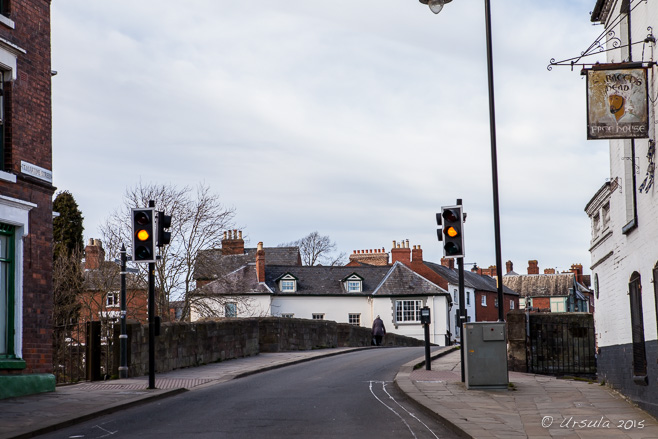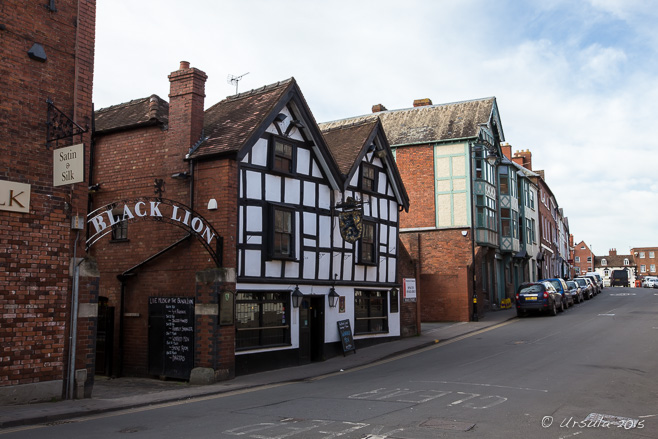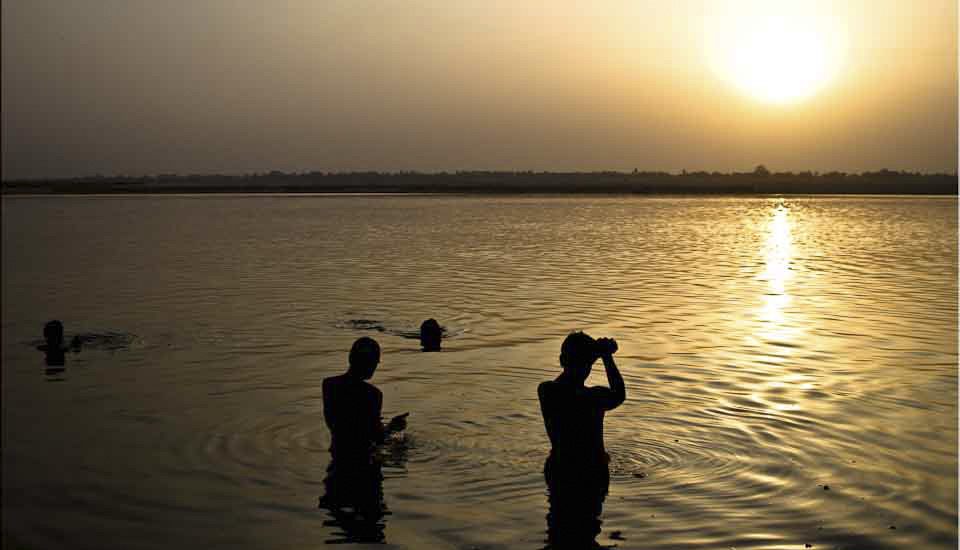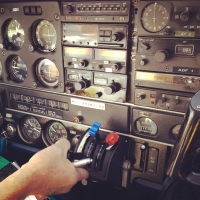
Hereford Cathedral on the River Wye
The old market city of Hereford was granted a town charter in 1189 by Richard I of England, but has been recognised as a city since time immemorial. (26January2015, iPhone5)
Everywhere you look in Hereford, in the British Midlands, you see history.
As a city it dates back to Saxon times, when the Bishop of Hereford was first installed some time between AD 676 and 688. But it has operated as a cross-roads market-town for as long as anyone can remember. Today, its historical buildings serve as reminders of those past eras.

Welcome to Hereford
An old pub sign for the Saracens Head hangs over St Martin’s Street just south of the historic Wye Bridge. Built in 1490 and widened in 1826, the Grade I-listed river crossing takes local traffic north into downtown Hereford.
A short distance up-river is the newer A49 highway bridge which is more of a thoroughfare; down-river is the Grade II-listed Victorian-built (1898) Victoria Footbridge.

The Black Lion
On the other side of the Wye Bridge, we find the the Jacobean-fronted half-timber building that houses the Black Lion Pub. The Midlands is “Black and White” country (see: Medieval Ludlow), and a few of these distinctive buildings survive in Hereford itself.

The Left Bank Gate
The old streets hide modern facilities like the newly re-conditioned Left Bank event venue.

Gwynne Street
Narrow roadways lead into old Hereford city, …

Hereford Cathedral
… past the gothic-style cathedral (built 1110-c.1250), and into the old town …

Hereford Bull
… where Brian Alabaster’s bronze Hereford bull has taken pride of place in the square since 2012.

High Town
The “Old House” on the town square was built in 1621 as part of what was once “Butchers’ Row”. This well-preserved timber-framed Jacobean building is surrounded by newer architecture.

Pigeon on the “Old House” Roof

Window into the Old House
The box-framed building has been a museum to Jacobean times since 1929, but is not open every day. I had to be satisfied with peeping at the period furnishings inside through the windows.

Stained-Glass: All Saints, Church of England
The original All Saints Church dates from around 1200AD, but was damaged – probably by an earthquake. The existing building was completed about 1330. Re-opened in July 1997 after extensive repairs, the building is today a centre of arts, good-works, and worship in the middle of town.

Entry to Hereford Cathedral
There is no better example of Hereford’s long, rich history than the older, grander, Hereford Cathedral. The current building dates from 1079 and stands on a site – overlooking the Wye River – where cathedrals have been since Saxon times.

Magna Carta Exhibit
One of only four 1217 Magna Carta to survive is housed in Hereford Cathedral’s Chained Library. In 2015, the Cathedral organised exhibitions, displays, lectures, and special services to celebrate the 800th anniversary of this charter of legal rights.
Another precious treasure in the Cathedral is the Mappa Mundi, a medieval map of the world dating from the thirteenth century.

Tomb of Bishop James Atlay
Largely reconstructed during Norman times (1110-c.1250,) the current gothic-style Cathedral contains a number of effigies, tombs and beautiful stained glass windows. The North Transept, for example, features a six-panel window designed around 1864 by Hardman and Co., leading manufacturers of stained glass windows at that time. The left half of the window depicts living Christians working towards their faith, while the right half shows those who are already in Heaven.
The beautiful marble effigy on the Tomb of Bishop James Atlay (1868–1894) in the foreground was carved by James Forsyth (1827–1910).

Lady Chapel
The five stained glass panels of the East Window (1852) over the altar in the Lady Chapel tell the story of the life of Jesus.

Pilgrims Prayers
“Each candle represents a pilgrims prayer.”

The Mother
Votive candles are everywhere in the dark interior. Another set sits outside Audley Chapel, where the painting reads: “The Mother of God who points the Way.”

Thomas Traherne Stained Glass Windows
Four new stained glass windows were designed and created in 2007 by international stained-glass artist Thomas Denny (b.1956) for the newly restored Audley Chapel. They illustrate stories from the writings of Thomas Traherne, MA (1636 or 1637 – 1674), Hereford’s most celebrated poet, clergyman, theologian, and religious writer.

Eagle Lectern

Golden Globe
From the lectern, you can see over the pews, through the arches and out into the light.

Looking through the Choir

Winter Window
Outside Hereford Cathedral, the winter chill has left the trees bare.

Under the Hereford Corona
As evening approaches, Peter Dyke, Assistant Director of Music at Hereford Cathedral, discusses plans for Evensong with members of laity and clergy in the North Transept. Above them, the silver-gilt “Corona” representing Jesus’ crown of thorns, hangs suspended over the main alter. Designed and made by acclaimed silversmith Simon Beer, it was installed under the tower in 1992.

Satin and Silk
Evensong over, I reenter the quickly-darkening streets to make my way out of the old city…
 … and back over the Wye River to the newer suburbs where the young families who link Hereford’s Saxon past and it’s modern future, live.
… and back over the Wye River to the newer suburbs where the young families who link Hereford’s Saxon past and it’s modern future, live.




























.jpg)

